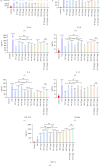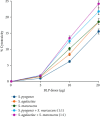Evaluation of Immunostimulatory Effects of Bacterial Lysate Proteins on THP-1 Macrophages: Pro-inflammatory Cytokine Response and Proteomic Profiling
- PMID: 40322557
- PMCID: PMC12048194
- DOI: 10.1155/jimr/2289241
Evaluation of Immunostimulatory Effects of Bacterial Lysate Proteins on THP-1 Macrophages: Pro-inflammatory Cytokine Response and Proteomic Profiling
Abstract
Bacterial lysate proteins (BLPs) serve as potential immunostimulants, recognized by pattern recognition receptors (PRRs) on immune cells, eliciting a robust immune response. In this study, THP-1 macrophages were treated with varying doses of BLPs derived from Streptococcus pyogenes (SP), Streptococcus agalactiae (SA), and Serratia marcescens (SM). The results showed significant increases (p < 0.05) in pro-inflammatory cytokines such as TNF-α, IL-1β, IL-6, IL-12, granulocyte macrophage-colony stimulating factor (GM-CSF), eotaxin, and macrophage inflammatory protein (MIP)-1α, except for 5 µg of all BLPs for TNF-α and eotaxin, and 5 µg of SP for IL-12 production. No significant differences were found between the corresponding doses of SP and SA or SP and SM, except for GM-CSF in all doses, while SA and SM only showed a difference at the 5 µg dose for GM-CSF. Furthermore, there were no significant differences between the 10 and 20 µg doses of all BLPs, indicating that doses higher than 10 µg do not significantly enhance the pro-inflammatory response. Combination doses of SP + SM and SA + SM did not show significant differences, except for IL-1β, suggesting no synergistic effect. Cytotoxicity was observed to increase with higher BLP concentrations in a dose-dependent manner, with combinations of SP + SM and SA + SM exhibiting greater cytotoxicity than the individual BLPs. Proteomic analysis of BLPs identified immunostimulatory proteins, including heat shock proteins (HSPs; ClpB, DnaK, and GroEL), metabolic enzymes (glyceraldehyde 3-phosphate dehydrogenase (GAPDH), enolase, and arginine deiminase (ADI)), and surface and secreted proteins (ESAT-6-like protein, CRISPR-associated endonuclease Cas9, OmpA, porin OmpC, and serralysin), which are involved in immune modulation, bacterial clearance, and immune evasion. This study underscores the potential of bacterial proteins as vaccine adjuvants or supplementary therapies; however, further research is essential to find a balance between immune activation and inflammation reduction to develop safer and more effective immunostimulants.
Keywords: bacterial lysate proteins; cancer; immunostimulants; infectious diseases; pro-inflammatory cytokines.
Copyright © 2025 Md. Mijanur Rahman et al. Journal of Immunology Research published by John Wiley & Sons Ltd.
Conflict of interest statement
The authors declare no conflicts of interest.
Figures





Similar articles
-
Differential regulation of lipopolysaccharide and Gram-positive bacteria induced cytokine and chemokine production in macrophages by Galpha(i) proteins.Immunology. 2007 Sep;122(1):116-23. doi: 10.1111/j.1365-2567.2007.02619.x. Epub 2007 May 2. Immunology. 2007. PMID: 17484771 Free PMC article.
-
Fish cell cultures as in vitro models of inflammatory responses elicited by immunostimulants. Expression of regulatory genes of the innate immune response.Fish Shellfish Immunol. 2013 Sep;35(3):979-87. doi: 10.1016/j.fsi.2013.07.015. Epub 2013 Jul 18. Fish Shellfish Immunol. 2013. PMID: 23872473
-
Dynamin inhibition interferes with inflammasome activation and cytokine gene expression in Streptococcus pyogenes-infected human macrophages.Clin Exp Immunol. 2014 Nov;178(2):320-33. doi: 10.1111/cei.12425. Clin Exp Immunol. 2014. PMID: 25079511 Free PMC article.
-
Systemic inflammatory response to exhaustive exercise. Cytokine kinetics.Exerc Immunol Rev. 2002;8:6-48. Exerc Immunol Rev. 2002. PMID: 12690937 Review.
-
Advances in Bacterial Lysate Immunotherapy for Infectious Diseases and Cancer.J Immunol Res. 2024 Jun 12;2024:4312908. doi: 10.1155/2024/4312908. eCollection 2024. J Immunol Res. 2024. PMID: 38962577 Free PMC article. Review.
References
MeSH terms
Substances
LinkOut - more resources
Full Text Sources
Research Materials

